Sparta, WI, August 2025
Time to buy the donuts would be closer, but they are tires, not donuts. A diet does strange things to your mind… mmmm, glazed all weather radials…
Some of the pictures are not perfectly focused, but they are good enough to see what is going on. If you were not aware, a penny can be used to check your tread depth. If you can see the top of Lincoln’s hair, you need to replace the tire. If they ever change the penny, the tire companies will probably lobby to have Lincoln’s head further from the edge, so you have to change your tires more often. Even if the tread is not worn out, the general guideline is that RV tires should be replaced every five years for safety.
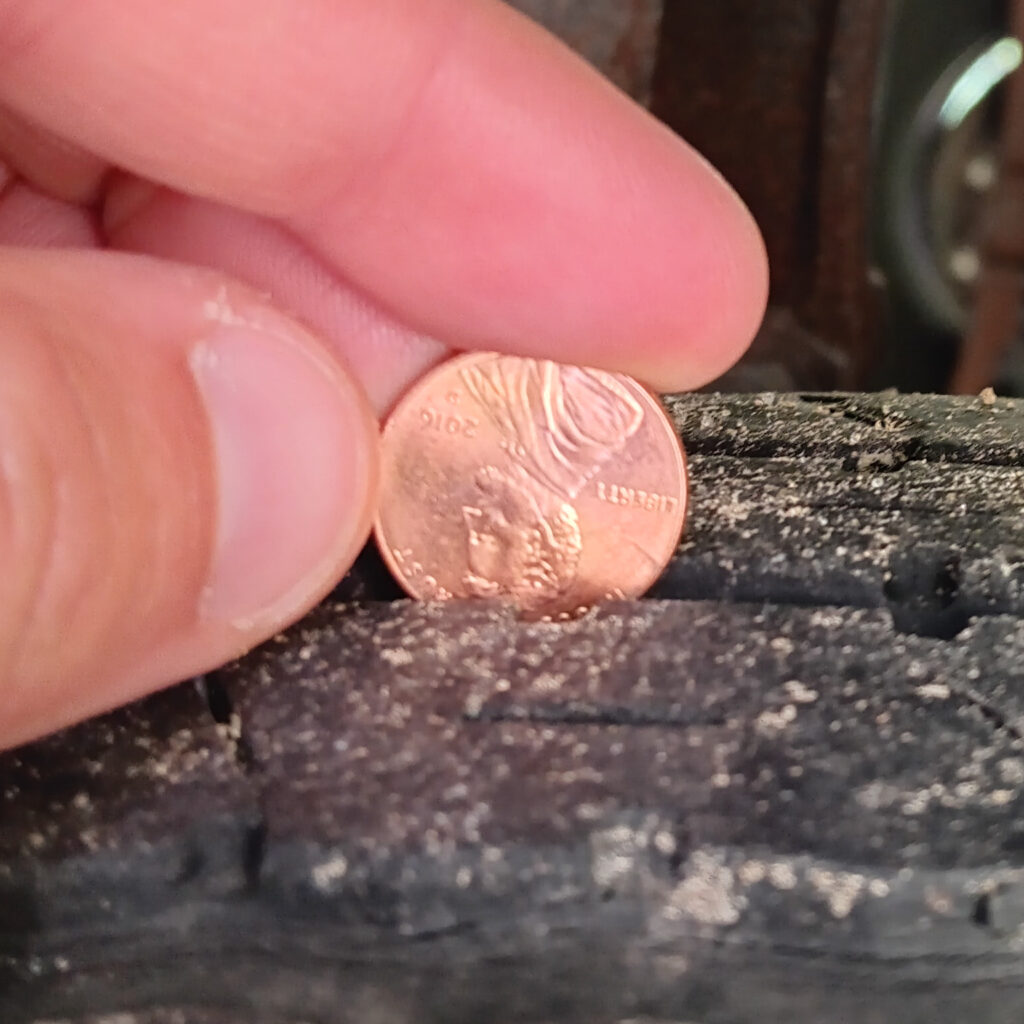

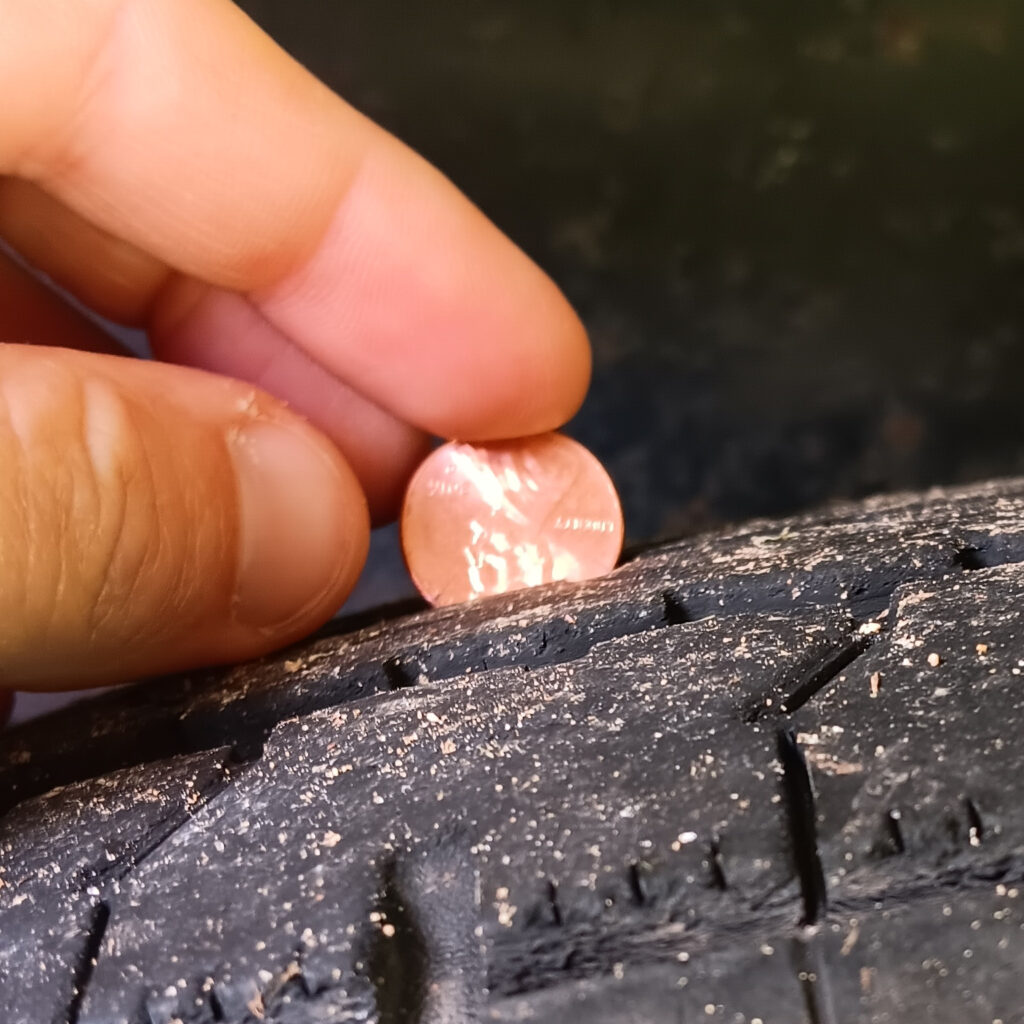
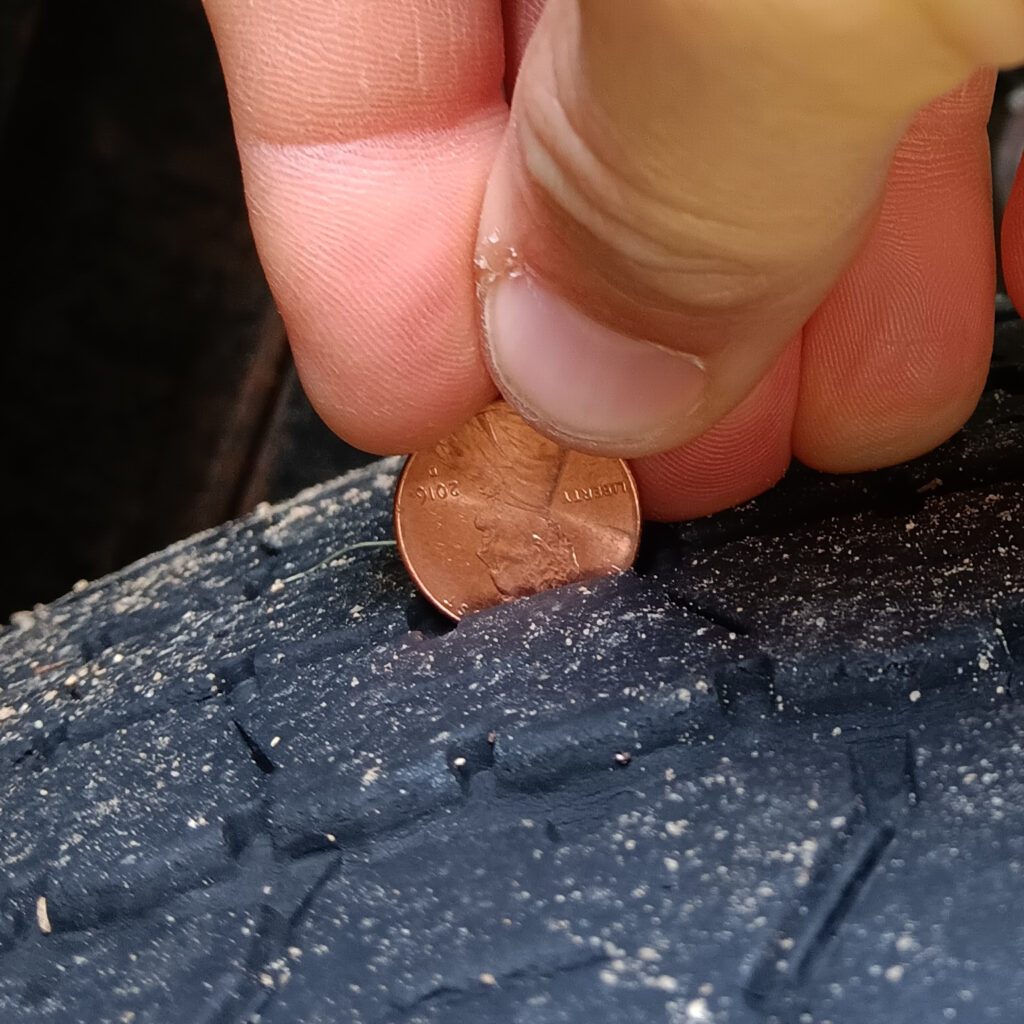
Currently, the front RV tires are getting close to worn out. These tires are more worn on either outer edge than the middle. This can be for several reasons, including cambered axle. Since the front axle is cambered, there is a good chance that it is not an issue.
Not surprisingly, it will probably be expensive to replace the tires. Even cheap RV tires are about $150 each as a minimum. Good ones are probably closer to $250+. Higher rated ones are closer to $300+. More surprisingly, tires are confusing. Being lighter, passenger car tires are a lot simpler and weaker. For larger and heavier vehicles, you need to worry about dimensions, load rating, load index, and speed rating. The tires that are currently on the RV are Goodyear Endurance ST235/80R16 123N/119 Load Rating E.
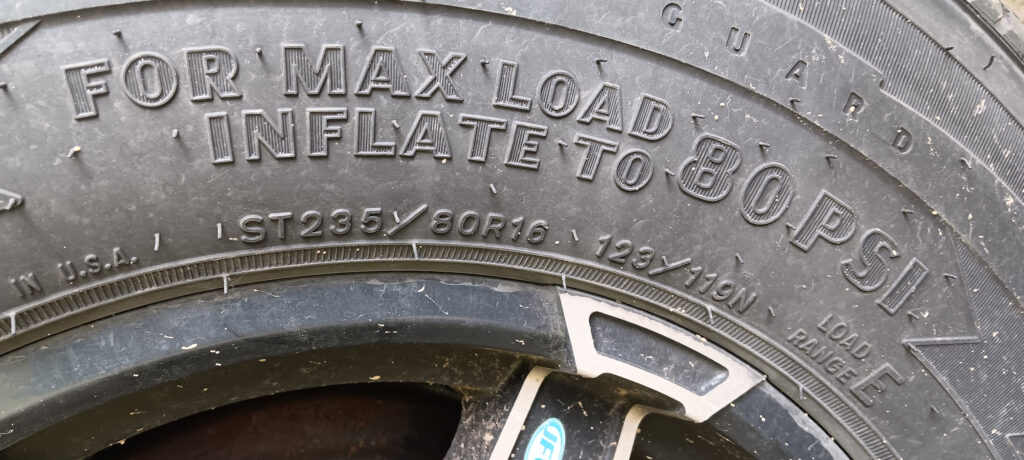
These values are:
(Type)(Width)/(Ratio)(Build)(Diameter) (Single Load)/(Dual Load)(Speed)
| Field | Value | Meaning |
|---|---|---|
| Type | ST | Special Trailer |
| Width | 235 | Width of the tire (between sidewalls) in mm |
| Aspect Ratio | 80 | Ratio of sidewall height to width |
| Build | R | Radial construction (R for Radial, D for Bias) |
| Diameter | 16 | Inches between the bead seat areas |
| Single Load Index | 123 | Load index for single axle use (3420 lbs) |
| Dual Load Index | 119 | Load index for dual axle use (3000 lbs) |
| Speed Rating | N | Maximum safe speed (87 mph) |
| Load Range | E | Ply-rating and max load pressure (10-ply, 80 psi) |
Clearly, they have selected these tires to be strong enough to hold up the RV.
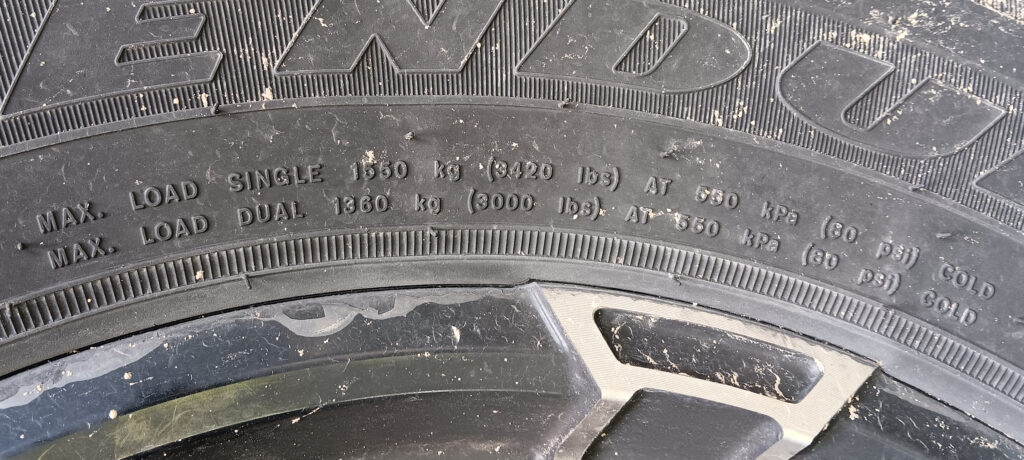
Dual axle max load is 3,000 pounds. Four tires, so 12,000 pound max. The RV has two 6,000 pound axles for a 12,000 pound max. The trailer is 14,000 pounds… Nope, they selected the cheapest weakest tires for the job. The hitch pin weight is about 2,000 pounds, so they are counting on the hitch taking part of the tire load. I guess they expect that we will never go up hill, down hill, over a bump, or through a pothole.
These are the tables of values for the various tire specifications. They are limited to subsets in the relevant range for the RV.
Load Index Table (subset)
| Load Index | Rate Max Load | Load Index | Rated Max Load |
|---|---|---|---|
| 114 | 2601 | 122 | 3307 |
| 115 | 2679 | 123 | 3417 |
| 116 | 2756 | 124 | 3527 |
| 117 | 2833 | 125 | 3638 |
| 118 | 2910 | 126 | 3748 |
| 119 | 1998 | 127 | 3858 |
| 120 | 3086 | 128 | 3968 |
| 121 | 3197 | 129 | 4079 |
Speed Rating Table (subset)
| Speed Rating | Maximum Speed |
|---|---|
| G | 56 mph |
| J | 62 mph |
| K | 68 mph |
| L | 75 mph |
| M | 81 mph |
| N | 87 mph |
| P | 93 mph |
| Q | 100 mph |
Load Range Table (subset)
| Load Range | Ply Rating | Max Load Pressure |
|---|---|---|
| B | 4 | 35 psi |
| C | 6 | 50 psi |
| D | 8 | 65 psi |
| E | 10 | 80 psi |
| F | 12 | 95 psi |
| G | 14 | 110 psi |
ST235/80R16 LR E Inflation Table (subset)
| PSI | Load Rating |
|---|---|
| 35 | 2090 lbs (B) |
| 50 | 2600 lbs (C) |
| 65 | 3000 lbs (D) |
| 80 | 3420 lbs (E) |
The ply rating does not indicate an actual number of plies. It is a strength rating based on tire construction with the number of plies using an outdated construction method. The “ply” is just a unit of strength, like feet is a unit of distance.
Some people buy different tires, but there appear to be some considerations related to this. These are the guidelines and concerns that are discussed in the forums and guides. Of course, opinions always vary.
- Never put on a tire with lower ratings than the original manufacturer tire
- Brand matters, but opinions vary
- Better: Goodyear, Michelin, Sailun, Hercules, Carlisle (new), Hankook, Maxxis
- Worse: Westlake, Carlisle (old), Deestone, Thunderer, Power King, Triangle, Castle Rock
- Tire construction matters
- All polyester
- Polyester with steel bands
- All steel
- Higher rated tires
- have higher tire pressure which
- can put more stress on the RV frame due to being stiffer
- can exceed the hub pressure rating for the tire bead
- can have larger dimensions which
- may not leave enough gap between the tires
- may change the height of the RV
- may need to run at reduced pressure for lower weigh loads
- may need to buy new rims to handle the higher pressure on the bead
- have higher tire pressure which
- Tire style matters
- Tire companies claim
- ST tires are specifically rated for trailers, not to flex for comfort
- ST tires are designed for sustained load with stronger sidewalls
- Some people that use LT tires (for light trucks) claiming
- ST tires are rated at exactly their maximum capability
- LT tires are underrated to give a safety margin
- Tire companies claim
A possibly concerning thing that I noticed is that the tires are not the same distance apart on either side. This could just be that the cambered wheels are not quite lined up, but it may mean that the axle was installed slightly skewed. This could be part of the cause of the greater wear on the front tires.
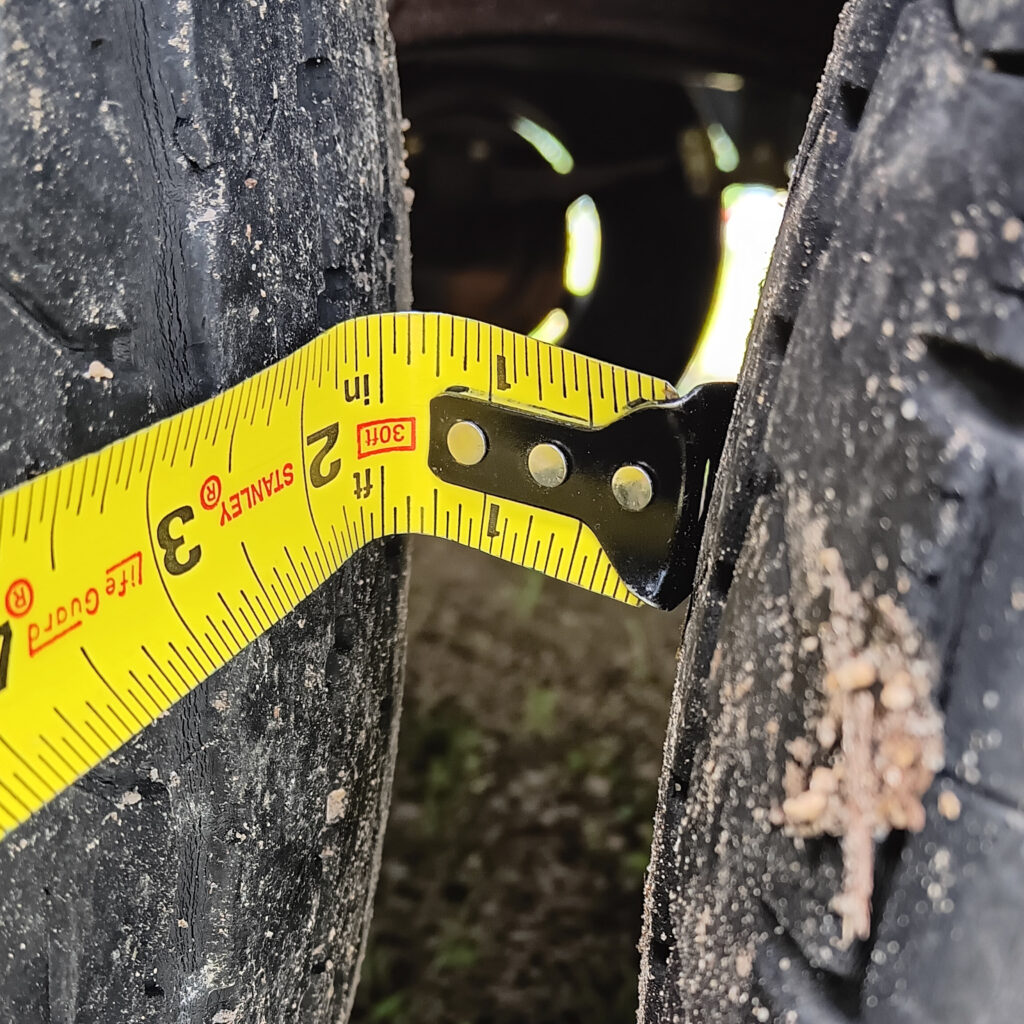
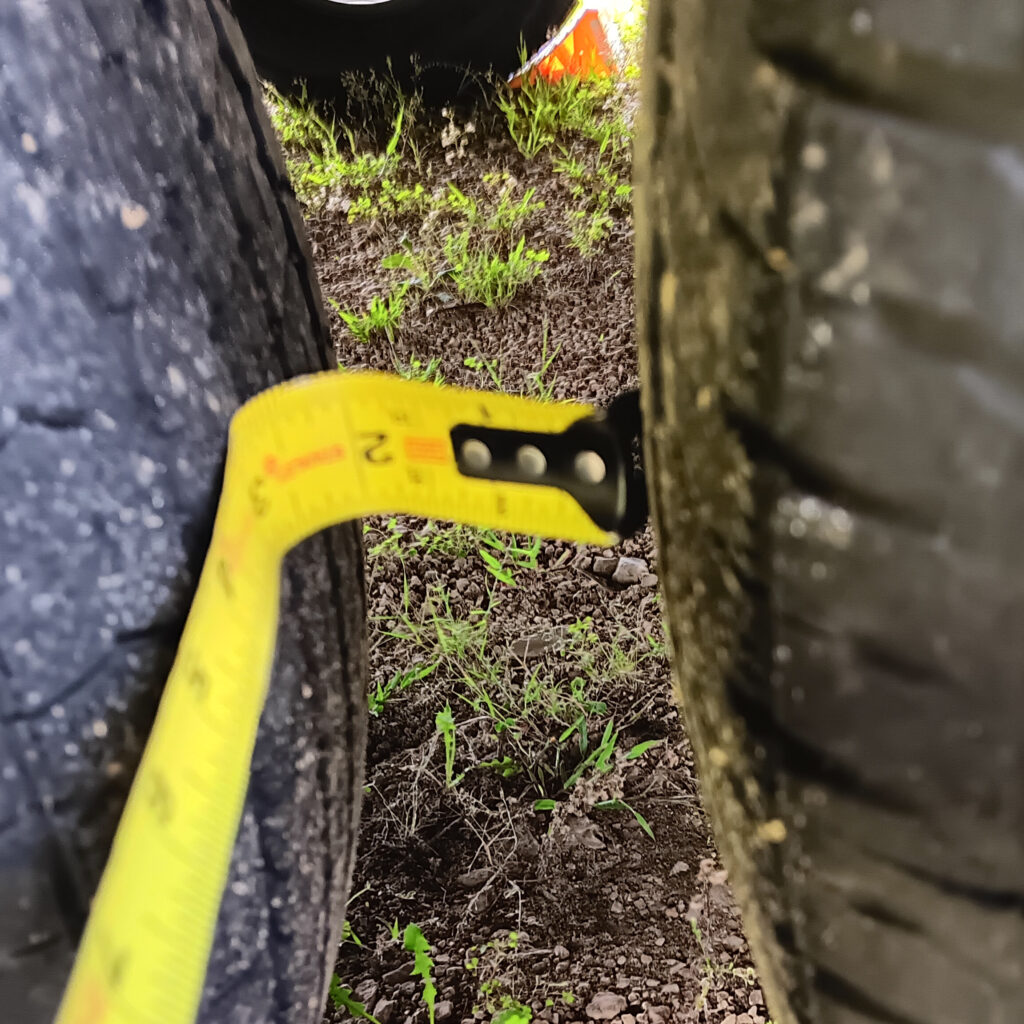
It seems like the options from the acceptable brands are:
- Goodyear Endurance
- https://www.goodyear.com/en_US/tires/endurance-trailer-tire/24464.html
- ST235/80R16 123N LR E
- Polyester with steel
- 3420 lb rated load
- 87 mph
- 10-ply
- 8/32″ tread depth
- 80 psi
- Stores:
- https://www.goodyear.com/en_US/tires/endurance-trailer-tire/24464.html
- Tires: $968.00
- T&I: $1063.80
- https://www.goodyear.com/en_US/tires/endurance-trailer-tire/24464.html
- Hankook Vantra ST01
- https://www.hankooktire.com/us/en/tire/vantra/trailer-st01.html
- ST235/80R16 123/119N LR E
- Polyester and steel
- 3417 lbs / 2998 lbs
- 87 mph
- 10-ply
- 8/32″ tread depth
- 80 psi
- Stores
- Maxxis M8008 Plus
- https://www.maxxis.com/us/tire/m8008-plus-st-radial/
- ST235/80R16 123/119N LR E
- Polyester and steel
- 3420 lbs / 3000 lbs
- 87 mph
- 10-ply
- 9/32″ tread depth
- 80 psi
- Stores
- Carlisle CARLSTAR CSL16
- https://www.carlstar.com/our-products/product-detail/csl16/
- 6H08101: ST235/80R16 129 M LR G
- All steel body
- 4080 lb rated load
- 81 mph
- 14-ply
- 10/32″ tread depth
- 110 psi (Requires high load capacity wheel)
- Stores
- https://www.discounttire.com/buy-tires/carlisle-csl-16
- Tires: $1,232.00
- T&I: ?
- https://www.discounttire.com/buy-tires/carlisle-csl-16
- Hercules H-901 ST
- https://www.herculestire.com/treads/h-901-st
- 95133: ST235/80R16 129/125L LR G
- All steel body
- 4080 lbs / 3640 lbs
- 75 mph
- 14-ply
- 14/32″ tread depth
- 110 psi (Requires high load capacity wheel)
- Stores
- https://www.tirebarn.com/tiremake/hercules/h-901-st/HER95133/
- Tires: $785.96
- T&I: $947.92
- https://www.tirebarn.com/tiremake/hercules/h-901-st/HER95133/
- Hankook Vantra TH31
- https://www.hankooktire.com/us/en/tire/vantra/trailerth31-th31.html
- ST235/80R16 129M LR G
- All steel body
- 4080 lbs
- 81 mph
- 14-ply
- 12/32″ tread depth
- 110 psi (Requires high load capacity wheel)
- Stores
- https://www.discounttire.com/buy-tires/hankook-vantra-trailer-th31
- Tires: $988.00
- T&I:
- https://www.discounttire.com/buy-tires/hankook-vantra-trailer-th31
- Sailun S637T
- https://gosailun.com/en-us/tbr/tires/s637t/
- https://gosailun.com/wp-content/uploads/2025/02/Sailun_MRT_Load_Inflation_Table_20250226.pdf
- 4112464: ST235/80R16 130/126M LR H
- All steel body
- 4190 lbs / 3750 lbs
- 81 mph
- 16-ply
- 10/32″ tread depth
- 120 psi (Requires high load capacity wheel)
- Stores
- Michelin XPS Rib (incorrect size)
This is still going to take a little more research, but it at least compiles most of the information that we need in one place. Additional notes will be added here.
- Tandem Axles
- Dexter D60
- Similar to tandem of current models:
- Markings
- Dexter # 5736575
- PO D083A – 001747
- Date: 2020-11-19
- Max Load: 6000 lbs
- Hub Face: 86.50″
- Spring Center: 68.50″
- Specs
- As marked
- 12″ x 2″ CSA approved electric brakes
- Replacement Parts
- https://www.etrailer.com/question-700068.html?srsltid=AfmBOopd7kth66SAsRzAhzxqGAvHkUJO6rHLhimwnV9NzmjuzF2lLMup
- Seal: #GS-2250DL: https://www.etrailer.com/Trailer-Bearings-Races-Seals-Caps/TruRyde/GS-2250DL.html
- Outer (1.25″) Hub Bearing: #15123: https://www.etrailer.com/Trailer-Bearings-Races-Seals-Caps/etrailer/15123.html
- Inner (1.75″) Hub Bearing: #25580: https://www.etrailer.com/Trailer-Bearings-Races-Seals-Caps/etrailer/25580.html
- https://www.etrailer.com/question-700068.html?srsltid=AfmBOopd7kth66SAsRzAhzxqGAvHkUJO6rHLhimwnV9NzmjuzF2lLMup
- Electric Drum Brakes 12″ x 2″
- Markings
- Drum
- “10 MTI” – just a casting number, meaningless
- “Max rebore 12.09 inches” – indicates max wear to still be safe
- “8-201” – Drum model number
- Brake
- Dexter
- 6-7KPRI-GG SEC-GG
- 5.2KPRI-FF SEC-FF
- 12x2DXQ 36-89
- Drum
- Replacement Parts
- Electric Brake (w or w/o Parking)
- Shoe and lining kit: #K71-127-00
- Electric Brake (Nev-R-Adjust)
- Shoe and lining kit (LH): #K71-675-00
- Shoe and lining kit (RH): #K71-676-00
- Electric Brake (w or w/o Parking)
- Markings
- Aluminum Alloy Rims
- Lionshead Aluminum Alloy Liger Wheel Rims (LH98VR)
- Specs
- 16″ x 6″ Rim
- 6 on 5.5″ lug pattern
- 200 psi with metal valve stem
- 80 psi with rubber valve stem
- 3330 lbs max load
- Spokes: (Verify)
- DOT-T B62971660
- 16x6J ET0 6-5.5
- C:, H:
- Max Load 3300 lbs
- 24?
- Fender Skirt
- Forest River Tandem Fender Skirt FS4482
- 67 7/8″ wide. 10 7/8″ tall at ends. 11 1/2″ tall in middle. 6″ long ends. 8″ long middle.
- https://www.icondirect.com/forest-river-tandem-fender-skirt-fs4482/?srsltid=AfmBOorUdtrzwWZtc4b-q48b-5wC8MrA6Tfq0geWh_FBQm3s9okCeIeH
- Forest River Tandem Fender Skirt FS4482
